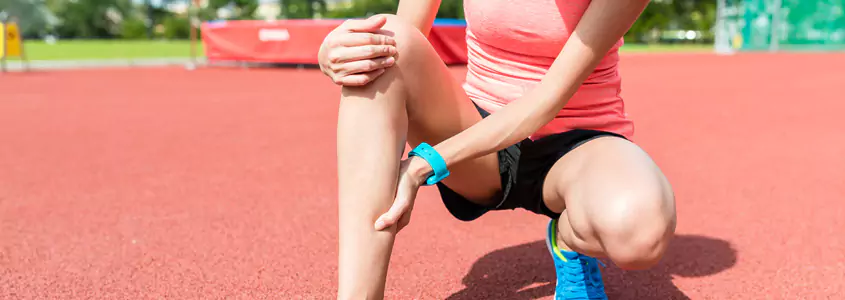There’s one question that is on the top every athlete’s list when they sustain an injury – when can I play or race again? It’s a question that I usually answer with another question; when do you need to? Sometimes there’s an important event or competition coming up and it needs to be considered in a management and treatment plan. Can you push the boundaries in returning to sport quickly? Yes. Is it the best thing to do? Read on.
In this article, I’ll run through six tips on how to get people back to sport as quickly, but as safely as possible.
Prevention is Better than Cure
In elite sport, there’s been a big shift in focus from injury management, to injury prevention. For example, recent research has clearly proven than football players can significantly reduce the chance of ACL (knee) injuries by at least 50% if they do certain exercises, and for injuries related to training load errors the acute on chronic workload ratio algorithm has been shown to help predict injuries.
Specific strengthening and training load management are the two most important factors in preventing injuries, however when athletes are leading into major events elite sport practitioners employ other strategies as well.
Shane Kelly is the Head of Physical Therapy for British Athletics, and he takes an individualised approach for their athletes leading into big competitions. “The modifiable risk factors of sleep, nutrition, travel and decision making are targeted and we have bespoke strategies for each of our athletes” says Shane. “Essentially, in order to maximise performance and reduce injury risk, every track and field athlete must be extremely well prepared in each of these areas”.An appropriate strength and conditioning program will help reduce the chance of injury
An appropriate strength and conditioning program will help reduce the chance of injury
Declare it, and Get an Accurate Diagnosis Quickly
If you are injured, it’s in your interest to acknowledge it, accept it, and get the professionals in to to help as soon as you can. Seeing how it goes for a few days may delay receiving optimal treatment and rehabilitation, so if you’ve got a tight timeline, get things checked straight away.
World Tour Cycling Team Mitchelton Scott has strict policies on riders reporting injuries. It’s a straight forward process when on tour with the team, however the challenge is when the riders are away from the team. “The issue is when riders are at home, often in different time-zones and sometimes isolated” says Dan Guillemette, Lead Physiotherapist. “Fortunately, we have a good concentration of athletes in Girona and Andorra who can quickly access medical services within a trusted network of external practitioners. The key is the open communication between the athlete, coach, our medical team, and external provider.”Dan Guillemette preparing a Mitchelton Scott rider with Premax Massage Lotion
Dan Guillemette preparing a Mitchelton Scott rider with Premax Massage Lotion
The take home message is to have your own trusted medical ‘team’ set up before you get injured. If you don’t have people already on your team, word of mouth is always best.
Once the injury has been disclosed, sports medical practitioners need to provide you with an accurate diagnosis. Sometimes, this can be provided clinically, however most of the time professionals need to push the limits with what can be done, and early imaging (x-ray, MRI, ultrasound etc) is used to clarify both the diagnosis and severity.
Aggressive Early Management
You’ll be tempted to put your feet up and feel sorry for yourself, however there’s plenty you can do to optimise your recovery from day 1.
Kristy Stahr is a US Physical Therapist who has spent years travelling around the world with the Williams sisters and Naomi Osaka. She knows what it takes to have players ready to play again in short time frames.
Kristy says that reducing swelling is a high priority in the early stages. “It is imperative to decrease/abolish any swelling quickly after the initial injury to facilitate healing. This can be done through massage, cryotherapy with compression, manual lymph drainage techniques, dry needling protocols and various taping” says Kristy.
Getting the injured region moving as soon as able is also of paramount importance. Kristy says that “movement is also key during the early stages as long as stability/structural integrity is not compromised. Early movement helps to maintain range of motion and also activates muscle pumps to further decrease any residual swelling”.
For longer term injuries, there’s a few things to do also in the early stages;
- Maintain as much strength in the muscles surrounding the injury as you can. If you’ve injured your hamstring for instance, keep some exercises going for the calf, quads and gluteals as well as the other leg and upper body
- Maintain your aerobic condition. Can’t use your leg? Get on the grinder, or swim some laps with a pool buoy. Injured your collar bone or shoulder? No problem – you can still ride on the trainer.
Cold water hydrotherapy is often used by elite athletes after an injury to promote early-stage movement
Cold water hydrotherapy is often used by elite athletes after an injury to promote early-stage movement
Understand and Respect Healing Times
Despite what some people may say, you can’t hurry nature. A broken bone takes 6-8 weeks to mend irrespective of cryotherapy chambers, laser, pulsed ultrasound, hyperbaric therapy, vitamins or magic wands. The same kind of thing goes for high-grade muscle and ligament injuries. Whilst you can maintain fitness and strength, if an injury needs to ‘heal’ – you have to do the time. Well, most of the time.
The art in sports medicine is to know how to work around an injury. For example, if an athlete has a low-moderate grade strain of the medial ligament (MCL) in the knee, it may take 4-6 weeks to heal completely, however if clinicians are happy with the structural stability of the ligament, clinicians may inject the ligament with local anaesthetic to allow the athlete to compete at 1-2 weeks.
As always, get good advice and make an educated mutual decision on risk vs reward (more on this later). Shane Kelly from British Athletics says “my tip is to inform the athlete and coach at every stage about the increased risk and thus any decision to continue is an informed one. Our role as the support team is to provide the athlete and coach with as much information as possible to make the best decisions about their rehab and continuing to compete.”
Do the Therapy & Rehabilitation
To get over an injury quickly takes everything you need to also be a good athlete – hard work, dedication, consistency, courage… I could go on.
Pain is a powerful motivator, however when the pain resolves many people are left with residual weaknesses, tightness, and/or sub optimal biomechanics etc, but they get back to full training as the pain is gone (for now).
A good sports medical practitioner will educate athletes on the process of returning to sport so people don’t drop off from therapy and rehab before it’s time. Having a criteria-driven approach to return to sport that encompasses pain levels, strength, function, and fitness measures is very important.
Dan Guillemette from Mitchelton Scott says that having a knowledge of the rider makes a huge difference in knowing how hard to push, and when the time is right to return. “Understanding the individual rider as well as having baseline screening data allows us to design an optimal treatment approach specific to the injury and rider, and helps us predict how riders will adapt and respond during rehab and when they return to training”.Complete the rehabilitation to ensure you have a better chance of successfully returning to sport after an injury
Complete the rehabilitation to ensure you have a better chance of successfully returning to sport after an injury
Weigh up Risk and Reward
Every injury and situation is different and should be treated accordingly. Some consideration must be given to the stakes, i.e. how important competing in an event is to the athlete, and also all the ‘what if’s’ that may eventuate if things don’t go to plan.
It’s a situation Kristy Stahr faces on regular basis with her tennis players, and she says that good communication and a team approach is what works best. “Due to the taxing tournament and travel schedules, it is of the utmost importance to maintain open, direct and honest communication with the athlete, coach and fitness trainer in regards to return to play.”
“My individual role is to advise the athlete and the team of possible short and long term risks to competing so that together we can determine what our end goal is and which tournaments take priority” says Kristy.
For team sports, taking that extra week may make the difference between seeing out the full season or sustaining a re-injury and missing another month. Ensuring that you’re not letting down the team by competing when you’re not ready is also worth careful consideration.
Individual sport athletes need to search deep on why they do what they do. Does the goal of competing in an event and risking re-injury outweigh the lifestyle and pleasure of regularly training with like-minded friends?



